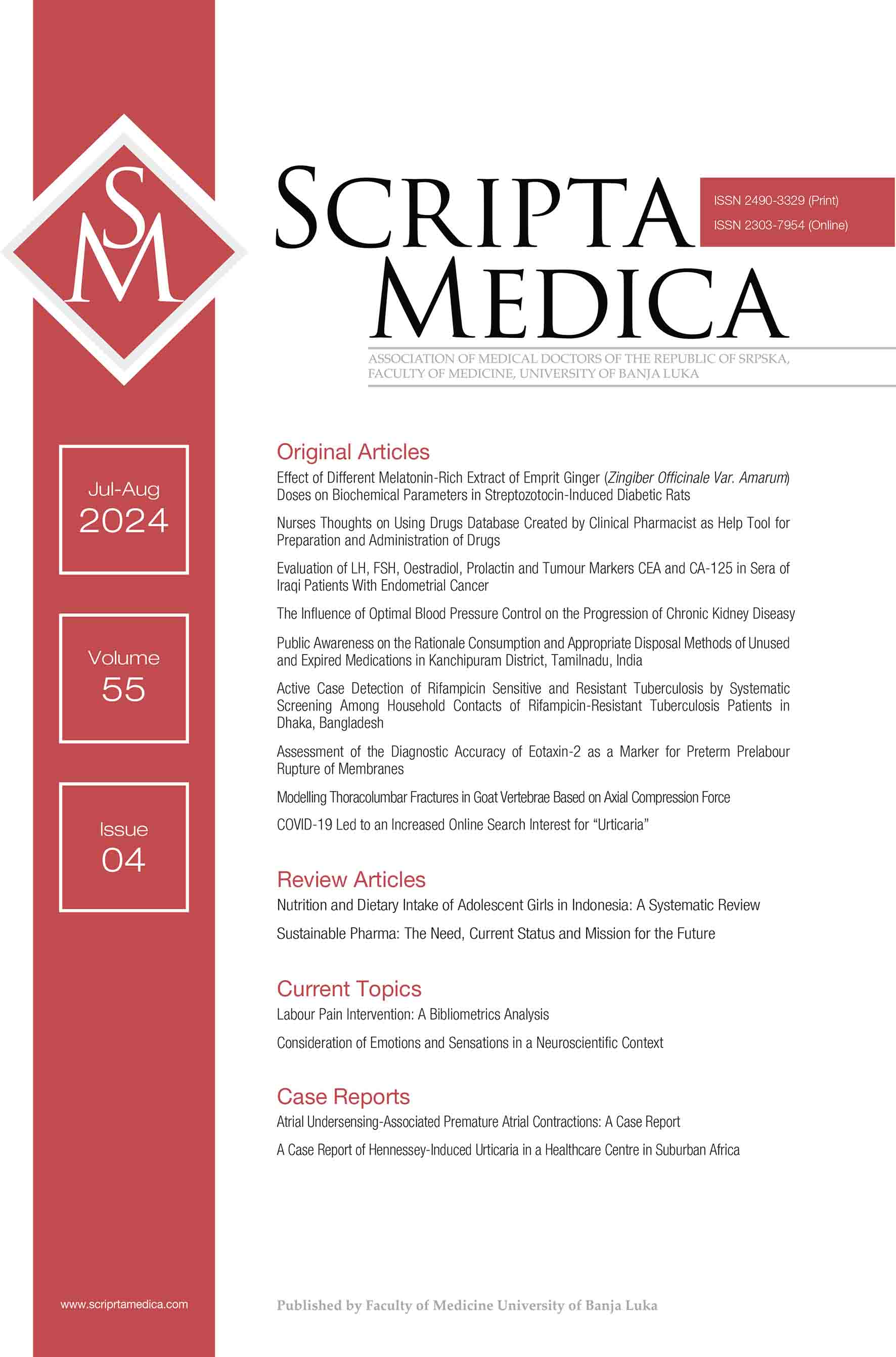Nurses Thoughts on Using Drugs Database Created by Clinical Pharmacist as Help Tool for Preparation and Administration of Drugs
Sažetak
Background/Aim: Intravenous therapy is a complex process usually requiring the preparation of the medicine before administration to the patient and it is well known that errors in preparation and administration can cause harm to patient. Systems that use information technology are key components of strategies to prevent medication errors in developed countries. Therefore, aim of study was to investigate nurses’ perspective on medicines database in clinical information system implemented in university hospital.
Methods: A convenience sample of 79 nurses at the bedside from four different hospital wards in the 1200-bed university hospital were asked to participate in the study. The questionnaire included twenty-three questions organised in three different sections and it assessed 3 components of the medicines usage: (1) medicines preparation; (2) medicines administration; (3) clinical information system use. Mean scores were calculated for the 4- item Likert-type scales.
Results: Most nurses found information in drug database reliable (Likert scale mean = 1.42 ± 0.778) and believed that using medicines database can decrease drug preparation and drug administration errors (mean: 1.35 ± 0.717) with no significant difference in mean between four different wards. Similarly, most nurses were familiar with the drug database in clinical information system (mean: 1.22 ± 0.613).
Conclusion: Pharmacist as a drug expert could introduce medicines database to nurses, train them how to use it in everyday practice and explain how using information technologies can help in decreasing medication errors which leads to increasing patients’ safety during hospitalisation.
Reference
Franklin N. Identifying medication documentation errors using handwritten versus pre-printed ICU flowcharts. Aust J Adv Nurs. 2012;29:30-9.
Cousins DH, Upton DR. Medication error report 125: A patient dies following cross infection with falciparum malaria. Pharm Pract. 1999;9:220–2.
Cousins DH, Upton DR. Medication error 79: How to prevent IV medicine errors. Pharm Pract. 1997;7:310–1.
Schmidt CE, Bottoni T. Improving medication safety and patient care in the emergency department. J Emerg Nurs. 2003;29:12–6. doi: 10.1067/men.2003.19.
Ahmadizar F, Soleymani F, Abdollahi M. Study of drug-drug interactions in prescriptions of general practitioners and specialists in Iran 2007–2009. Iran J Pharm Res. 2011;10:921–31. PMID: 24250431
Naylor CD: Putting evidence into practice. Am J Med. 2002;113:161-3. doi: 10.1016/s0002-9343(02)01215-9.
Murphy AL, Fleming M, Martin-Misener R, Sketris IS, MacCara M, Gass D. Drug information resources used by nurse practitioners and collaborating physicians at the point of care in Nova Scotia, Canada: a survey and review of the literature. BMC Nurs. 2006 Jul 6;5:5. doi: 10.1186/1472-6955-5-5.
Mongan JJ, Ferris TG, Lee TH. Options for slowing the growth of health care costs. N Engl J Med. 2008; 358: 1509–14. doi: 10.1056/NEJMsb0707912.
Hillestad R, Bigelow J, Bower A, Girosi F, Meili R, Scoville R, Taylor R. Can electronic medical record systems transform health care? Potential health benefits, savings, and costs. Health Aff (Millwood). 2005;24:1103–17. doi: 10.1377/hlthaff.24.5.1103.
Amarasingham R, Plantinga L, Diener-West M, Gaskin DJ, Powe NR. Clinical information technologies and inpatient outcomes: a multiple hospital study. Arch Intern Med. 2009;169:108–14. doi: 10.1001/archinternmed.2008.520.
Jha AK, Orav EJ, Ridgway AB, Zheng J, Epstein AM. Does the Leapfrog program help identify high-quality hospitals? Jt Comm J Qual Patient Saf. 2008;34:318–25. doi: 10.1016/s1553-7250(08)34040-9.
Jember A, Hailu M, Messele A, Demeke T, Hassen M. Proportion of medication error reporting and associated factors among nurses: a cross sectional study. BMC Nurs. 2018 Mar 12;17:9. doi: 10.1186/s12912-018-0280-4.
Bifftu BB, Dachew BA, Tiruneh BT, Beshah DT. Medication administration error reporting and associated factors among nurses working at the University of Gondar referral hospital, Northwest Ethiopia, 2015. BMC Nurs. 2016;15:43. doi:10.1186/s12912-016-0165-3.
Agrawal A. Medication errors: prevention using information technology systems. Br J Clin Pharmacol. 2009 Jun;67(6):681-6. doi: 10.1111/j.1365-2125.2009.03427.x.
Griffiths P, Riddington L. Nurses' use of computer databases to identify evidence for practice--a cross-sectional questionnaire survey in a UK hospital. Health Info Libr J. 2001 Mar;18(1):2-9. doi: 10.1046/j.1365-2532.2001.00312.x.
Chedoe I, Molendijk H, Hospes W, Van den Heuvel ER, Taxis K. The effect of a multifaceted educational intervention on medication preparation and administration errors in neonatal intensive care. Arch Dis Child Fetal Neonatal Ed. 2012 Nov;97(6):F449-55. doi: 10.1136/fetalneonatal-2011-300989.
Nguyen HT, Pham HT, Vo DK, Nguyen TD, van den Heuvel ER, Haaijer-Ruskamp FM, et al. The effect of a clinical pharmacist-led training programme on intravenous medication errors: a controlled before and after study. BMJ Qual Saf. 2014 Apr;23(4):319-24. doi: 10.1136/bmjqs-2013-002357.
- Authors retain copyright and grant the journal right of first publication with the work simultaneously licensed under a Creative Commons Attribution License that allows others to share the work with an acknowledgement of the work's authorship and initial publication in this journal.
- Authors are able to enter into separate, additional contractual arrangements for the non-exclusive distribution of the journal's published version of the work (e.g., post it to an institutional repository or publish it in a book), with an acknowledgement of its initial publication in this journal.
- Authors are permitted and encouraged to post their work online (e.g., in institutional repositories or on their website) prior to and during the submission process, as it can lead to productive exchanges, as well as earlier and greater citation of published work (See The Effect of Open Access).

